Nailed Wood Boxes
© Tony Hyman
07-21-17 Updated 03-18-19

Nailed Wood Boxes
© Tony Hyman
07-21-17 Updated 03-18-19
Trimmed Nailed Wood boxes
NW 13/13
NW 12/12
NW 12/6 “salesman’s sample”
Cigars by J.W. Gohn Cigar Co., Fact. Cigars by United Cigar, Fact. Cigars by J.H. Fink, Fact. 1220,
396, 9th PA (East Prospect) 1903. 1116, 3rd NYC c1905. Cut 1st PA (Allentown) c1922. Only full
Custom label. [6604] down inner and flap [6613] size inner I’ve seen on a 12. [6675]
Click <here> see an exhibit of Salesmen’s Sample boxes.
NW 12/4 “salesman’s sample”
12th PA (Canton, PA) with cut-down outer c1905. 18th Ohio (15 Middle St., Cleveland) custom c1905
Salesman’s Sample boxes of 12 were legalized in 1891 and remained the smallest box of cigars until 1910 when 5’s and 10’s were authorized. It is possible to pack 12 cigars in a box three different ways, 12/4. 12/6, and 12/12. In a NW 12/4 box cigars were packed horizontally (side to side), three high and four across. More often than not, the NW12/4 size box has a custom label designed to fit the small shape, tho this type box is sometimes found with cut down labels as well.
NW 10/5
[Left to right]
S.C.W. cigars by G.J. Johnson, Fact. 45, 4th Dist. (Grand Rapids) Illinois in 1910.
Custom label was practical because this was a large volume brand. [6632]
PLANTERS SMILE cigars by Z.B. Toomey, Fact. 269, 9th PA (Dover) in 1912 with
overall lid and top oval used as an inner. [8190]
EL DIMISCO Generals cigars by A.J. Dimming, Fact. 353, 1st PA (East Greenville) c1922
with inset lid and outer label used as an inner. [6636]
CLAUDY ESTELLA cigars by E.J. Sitler, Fact. 1852, 9th PA (East Prospect) c1912 with inset lid.
Rare vertical 10 packing requires severely cut-down label used as an inner. [6661]
NW 10/10
The tiniest tax paid 10/10 houses
3/4 inch long cigars from 1930.
That’s a nickel along side it.
[4479]
NW 5/5
NW 3/3
The smallest legal cigar box holding 3 cigars was first permitted in 1926. The nation’s largest user of NW 3 boxes was R.G. Sullivan who gave them to visitors and sold them with custom labels for banquets, events and tobacconists. Their cigars were made in Fact. 57 in New Hampshire, 1937.
This odd trapezoidal covered in gold paper was a Golden Anniversary gimmick given away by Eli Witt Co. at the 50th annual convention of the Florida State Pharmaceutical Association in St. Petersburg, May, 1937. Cigars were made in
Factory 174 Florida.
[4458]
NW 1/1
This 9” jumbo’s cellophane wrapper is marked Broadway Special, New York Souvenir, A Fine Smoke - Mild & Mellow, Mfc. by Jose Capitaro, 1668 B’way, N.Y.C. [4464]
Custom labels
Stock labels
[left] Cigars made by Hull, Grummond & Co., a 250 roller factory (227, 21st tax district) in Binghamton, NY, for A. Ethridge & Co., Rome, NY 1885
[right] Cigars made by Ullman, Bloom & Co., a 115 roller factory (272, 6th tax district) in Dayton, OH, for Jno. A. Gorly & Co., St. Louis, MO 1885
An estimated 2,000,000 different brands of cigars were offered.
[9888]
[3209]
Cigar boxes were usually delivered from the box company to the customer by horse and buggy, train, or canal barge wrapped in brown paper bundles tied with cord. A bundle could contain any number of boxes, usually in units of 50 or 100 depending on the size of the cigar factory’s order. It was not unusual for a cigar factory to place standing orders such as “ship 5,000 every two weeks.”
Ordering trimmed boxes
To learn more about box factories, eventually you will be able to click <here>.
To learn more about lithographers and label printing, eventually you will be able to click <here>.
Trim
Trim is applied partly at the box factory and partly at
the cigar factory after the box is packed full of cigars.
Most is optional, some required by law. Trim includes:
 top brand on outside top of lid to identify brand name,
top brand on outside top of lid to identify brand name,
 edging to cover the joints and nail heads,
edging to cover the joints and nail heads,
 inner label to attract the smoker’s eye,
inner label to attract the smoker’s eye,
 outer/end label to identify the product on a shelf,
outer/end label to identify the product on a shelf,
 liner to prevent cigars from interacting with the wood on the sides and bottom,
liner to prevent cigars from interacting with the wood on the sides and bottom,
 flaps to protect the inner label from the cigars,
flaps to protect the inner label from the cigars,
 required factory ID (1868-1962+)
required factory ID (1868-1962+)
 required Caution Notice (1868-1959)
required Caution Notice (1868-1959)
 required Tax Class Notice (1917-1962)
required Tax Class Notice (1917-1962)
 required Federal tax stamp.
required Federal tax stamp.
 frontmark identifying size and shape of the cigar,
frontmark identifying size and shape of the cigar,
 color mark stamped / pasted on to note the cigars’ color,
color mark stamped / pasted on to note the cigars’ color,
 nail tag to cover the nail which seals the box,
nail tag to cover the nail which seals the box,
 price stickers,
price stickers,
 cigar bands for decoration,
cigar bands for decoration,
 banners across the inner label with ads or offers,
banners across the inner label with ads or offers,
 tags glued inside front, back or sides with ad copy,
tags glued inside front, back or sides with ad copy,
 distributors label to identify the distributor.
distributors label to identify the distributor.
To learn more about these and other labels and trim,
click <here>.
Construction
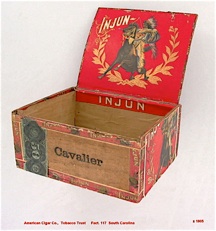
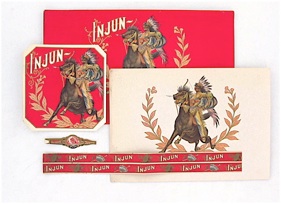
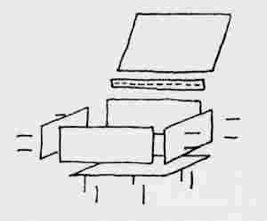
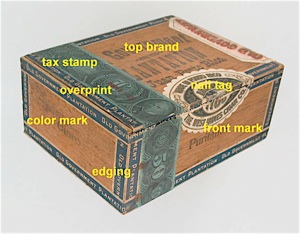

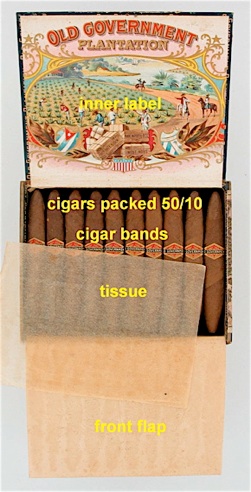


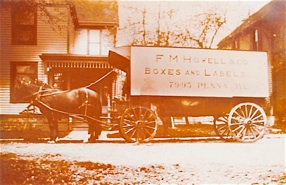


A major new “wing” is under construction here at Hyman’s National Cigar Museum which will feature more than 2,000 examples of the most popular 50 themes in cigar advertising, custom labels, and vanity labels used between 1860 and 1960. Click <here> to visit.
SIZES AND SHAPES OF NAILED WOOD BOXES
Just as there are a seemingly endless supply of different labels, Nailed Wood boxes were made
in a huge variety of sizes and shapes. One purpose of this exhibit is to introduce you to each of the standard sizes permitted by law between 1860 and 1960. I follow box maker practice describing a box with two numbers, the number of cigars in the box and the number of cigars in the top row.
All comments regarding boxes, stamps or the law refer to the century 1860 to 1960.
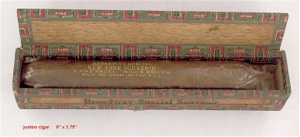
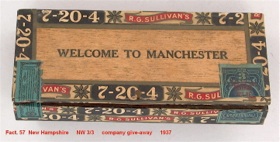
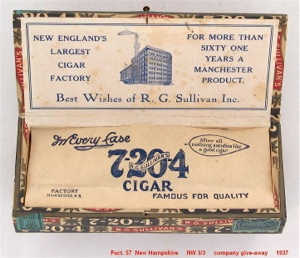
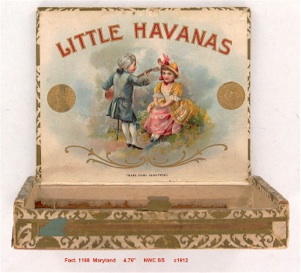
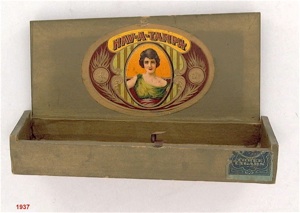
NW 20/10
Sorry,
photo
unavailable.
NW 25/5
Fact. 320, 21st New York c1883 Fact. 515, 14th New York c1885 11th Ohio (Shelby) c1886
Maker unknown. Fact. 2216, 9th PA c 1886
NW 25/13
Cigars by Chauncey M. Neff, Yoe, PA Cigars by John Trask, Gloucester, Mass
Fact. 1360, 1st Dist. PA, c1930 [7011] Fact. 47, 3rd MA, c1885 [2702]
NW 25/8 and NW 25/25
25/25’s can be square like this 1905 BACHELOR by Milwaukee’s Victor Thorsh and also as long novelties with 25 cigars in a row. Both forms are generally seen only at the Christmas season. These odd boxes are usually SBN’s rather than Nailed Wood boxes. The Boite Nature exhibit contains one of the few long 25/25’s I’ve seen in 70 years collecting. Note the added hinges to an NW box to support the heavy lid.
NW 50/10
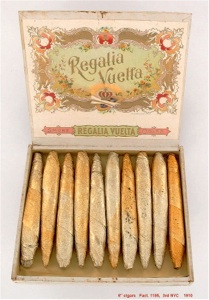

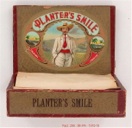

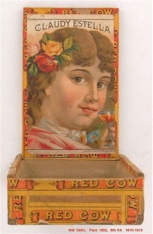
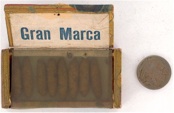
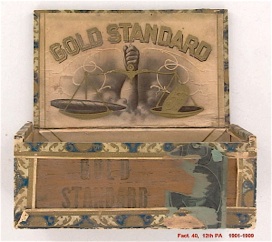
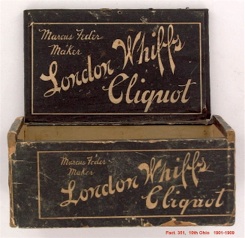
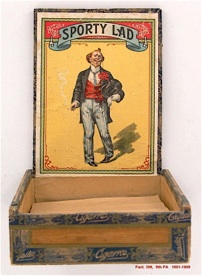
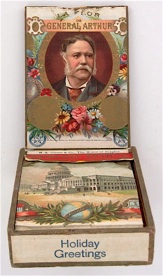
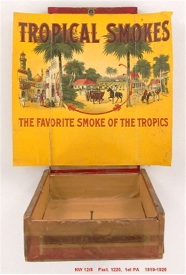
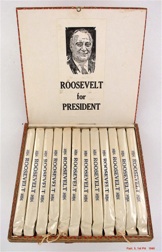

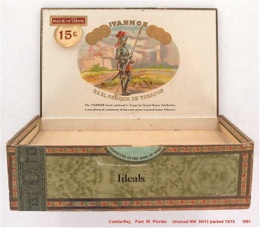
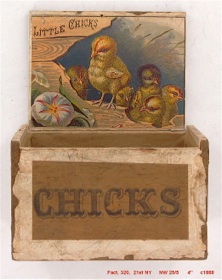

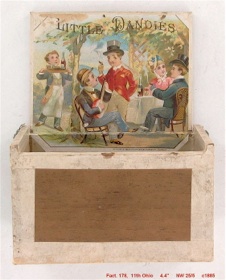
[4447] [4448] [4449]
[4477]

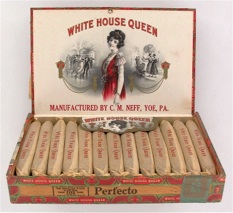
NW 50/17
Cigarette-size cigars
made in Fact. 1790,
3rd NYC c1890.
[4452]
Crooks made in PA,
early 1970’s.
[7123]
Crooks are rectangular cigars, stacked on their short side so more fit across. Only 3 deep.
NW 50/50
NW 100/10
NW 100/13
Fact. 618, 18th Ohio, c1880. Early 70’s style Fact. 2898, 9th PA, 1898. Typical cheap dropfront
with overall lid and outer label used as inner. cigar box using inexpensive monochromatic labels.
[5802] A curator’s favorite [4382]
Between 1800 and the 1880’s the most popular way to pack a box of 100 was 13 across front to back, 8 rows deep. More NW 100/13’s seem to have survived than any other size box made before 1885. That may not be a true reflection of how cigars were packed as 100/13’s tend to be more durable than other boxes of 100, and when empty hold bigger items and fit more conveniently on shelves, hence more likely to be kept when emptied. The fact that printers design stock labels for boxes of 13 probably played a role in the choice as well. After 1883, the 100/13 remains the most common 100, but NW 50/13’s become the most common box.
Only a few boxes of 100 are found with dropfronts, the correct name for the split front with the drop down panel. Cigars packed in dropfront boxes can be packed lying down or standing on end. When box brand names refer to two or three of something, or quote a price for multiple cigars, it typically indicates the cigars were banded or bundled together, probably standing on end.
Both boxes seen here have overall lids that rest on all four sides of the box, usually a sign of a box made before 1885, but required on any box with a dropfront.
Cigars packed in a NW 100/17 are stacked 6 high as opposed to the 8 of a NW 100/13 and the two styles can be difficult to tell apart. Fortunately, no one cares.
NW 100/20 “Cigarette boxes”
KEY WEST HAVANAS made in Fact. 874, Maryland
by an unknown Baltimore maker. c1884 [6353]
OFFICE BOUQUET was made by D.E. Rose & Co.
in Fact. 28, 2nd NYC, c1893. In today’s anti-smoking
climate, the idea of tobacco odor providing pleasant
bouquet for the office wouldn’t fly. [6357]
SANCHO was made in Fact. 184, Maryland, by
Maggie Schmidt, 1443 N. Gay St. Baltimore, c1890.
[6356]
standard 50/13 yet (and here’s the key) they held 100 smokes and have cigarette tax stamps.
What came in these attractive packages? They are labeled in a variety of ways, cigars, cigarros
(which is Cuban for cigarettes not cigars), all-tobacco cigarettes and cigarettes; They have
cigarette tax stamps and are frequently identified as cigarettes on the Caution Notice, but none
of that means much. Labels can legally say whatever they want and small cigars and cigarettes
were taxed, hence stamped, at the same rate as long as they weighed less than 3 lbs. per 1,000.
The cigarette boxes almost always have overall lids, 1883 tax stamps and contents made in New York or Maryland before 1897.
NW 100/20 and NW 100/25 “space hogs”
BUCK was made by Hampden Cigar Co., Westfield, Mass.
(Fact 36, 10th Dist. MA) between 1880 and 83. The graphic
style is that of the late 1870’s, fully explained elsewhere. [4488]
AB FRANK’S PLANTATION by W.J. Smith, 308 Commercial St., San Francisco, in Fact. 40, 1st Dist. Calif. in mid-1880’s [4367]
PLANTATION was made by F.W. Thomas & Co. (Fact. 773, Maryland) in Baltimore in the mid 1880’s. Flap contains a complaint about other companies copying their brand. [4368]

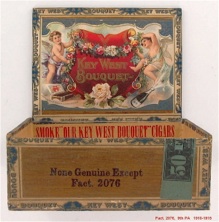
NW 50/13
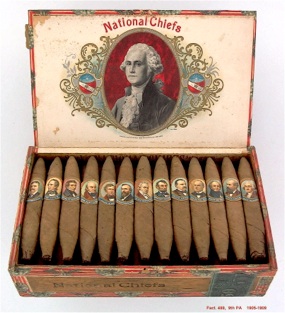
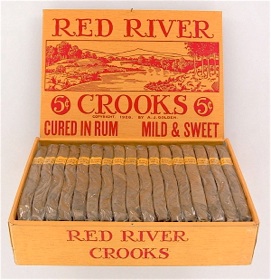
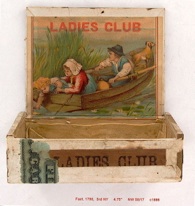
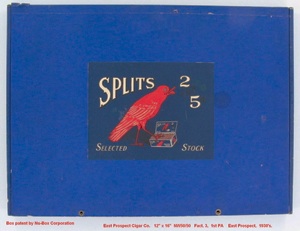

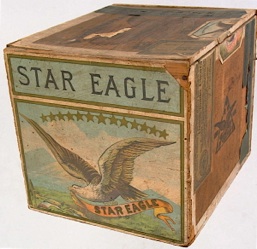
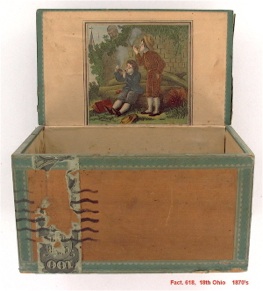

NW 100/50 & NW 100/100 & 200/anything
Sorry,
photo
unavailable.
Two packages you will probably never see and a third that’s almost as scarce.
Boxes of 200 were legalized in 1879, the 1st new box size permitted since 1865. Very few boxes of 200 turn up, almost all from the 1880’s. The few I’ve seen have been very idiosyncratic, some shaped like four boxes of 50 in a square, another like two 100 boxes end to end, another as if there were two boxes of 100 side by side. The heavy cigar sales in bundles of 2, 3, 4, 5...up to 9...adds to the difficulty of deciphering how the cigars were originally packed.
NW 500

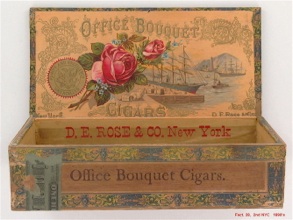
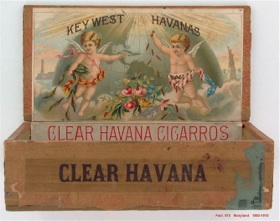
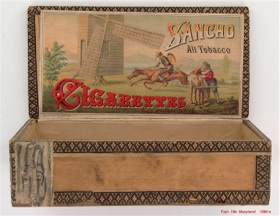
Wooden boxes of one-thousand, 500 and 250 were the three most common packages for cigars in international commerce prior to 1860. Tax laws of 1863 eliminated boxes of 1,000, leaving legal the “half box” of 500 and the “quarter-box” of 250. Half boxes were made from the same wood as smaller boxes, so were too fragile to survive much shop use but perfect for anyone wielding a coping saw..
In 68 years, I’ve seen only 3 boxes of 500 other than the sturdy walnut SBN saloon box called PRINCESS PRIZE.
The very desirable example at left held 3¢ cigars made in 1878 by Carney, Short & Co. of Scranton, PA (Fact. 82, 12th PA).
That’s a 15” ruler.
[DN8825]
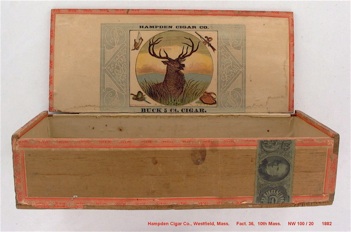
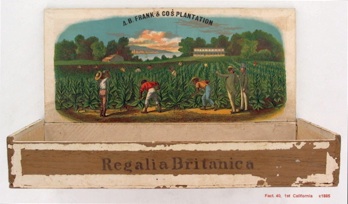

NW 250
WAR EAGLE Cheroots by Roth, Bruner & Feist,
a long time maker of cheap cigars and cheroots
in Cincinnati Fact. 387, 1st Ohio, 1898. Retailers got a free box of 25 OLD GLORY Cheroots free with each box of 250 WAR EAGLE they ordered.
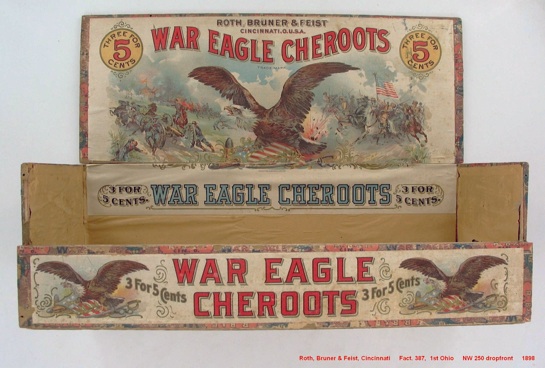
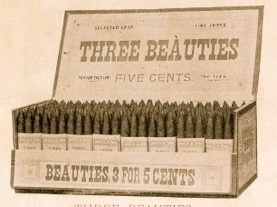

The most common way that cigars have been purchased for the last 80 years is in packages of 5, but NW 5’s are one of the most rare boxes because a nailed wood box of 5 is so much more expensive than a mass produced card-board five pack.
To make wood practical the cigars packed in them have to be more expensive. Modern (post 1960) wooden 5’s are usually SBN’s.
This box is especially rare because the top reads that the cigars inside were “manufactured by the Cigar Machine Corporation of America” and given away at a convention or trade show to demonstrate how good machine made cigars were in 1916, the year before the first such machine was put into commercial cigar factory operation.
[4457]
NW 12/12 is a very seldom used format, in part,
I believe, because the 13/13 was a very logical one and required less adaptation by the box factory to build.
The 1940 Roosevelt campaign selected 12/12 for their oversize foil-wrapped give-away cigars, probably because someone on the staff was triskadecaphobic, worried about the number 13 affecting the campaign.
Cigars made in Fact. 3, 1st tax District of PA by the East Prospect Cigar Co.
[6933]
Boxes of 13 were legalized in 1891 as samples.
NW 13/13 was a more logical configuration than 12/12 since most boxes of 50 had 13 cigars in the top row so a 13/13 sample box allowed salesmen to display the cigars and inner label exactly as a full 50/13 box would look. Sounds good but today’s collectors find few 13/13’s compared to the large numbers of 12/6’s. Was the NW 13/13 not popular with salesmen? More likely a 13/13 isn’t a very useful empty box so few of them got saved, skewing the sample. Many 13/13’s in the NCM collection, like this one, are cardboard, full, date from the 1970’s, and were gifts from cigar broker A.J. Jerry Golden.
[7085]
A most unusual box of 13 is this standard 50 box with an insert so the box could contain only one row of cigars. Why? Alas, we didn’t ask the Hollywood tobacconist for whom it was custom made back in 1951 by Cuesta Rey & Co. in Tampa’s Factory 55.
The Series 120 13 denomination tax stamp is rare.
[4344]
Packing regular size cigars in boxes of 20 was legalized in 1928, and 20’s are the only boxes that have a tax stamp dated 1928. The idea seems to have been to create a one buck package for 20 5¢ cigars, but the good-sounding idea appears to have been a failure as boxes of 20 are quite scarce and I have yet to find one (other than the KERNEL’S Petite) that isn’t made of cardboard. My guess is that it was special interest legislation, tho there’s no evidence of widespread use of boxes of 20 cigars by any of the major companies.
An NW 50/10 is a squarish box packed 10 cigars across, front to back, stacked 5 high. The oldest NW 50/10 I’ve found dates from 1871, so they’ve been around for a long time, but they’ve never been especially popular. Surprisingly, it wasn’t until the mid 1880’s that 50 boxes of any configuration became mainstream packing. Until then boxes of 100 were most popular with 25’s running a far distant second. You can often recognize a 50/10 because the inner label is frequently slightly trimmed on both sides. Cigars by J.C. Heckert & Co., Dallastown, Fact. 2076,
9th Dist. PA, c1912.
When most people think of a “cigar box,” what they are picturing is inevitably a Nailed Wood 50/13. No wooden box in history has been made in greater numbers, hundreds of millions of them between 1860 and 1960. The top three rows contain 13 cigars each, the bottom row only 11 and a wooden or cardboard “block” to fill in the space.
From a collector’s point of view, nailed wood boxes are rarely of interest in and of themselves. The main attraction of Nailed Wood [NW] boxes is their colorful labels, a topic I plan to explore in great detail eventually.
This box was used by Factory 489, 9th PA, owned by Jane Shindler of Red Lion, who rolled for twenty years. Fewer than 1% of factories were owned by women. Presidential band sets were sold in dime stores, and available today in many known varieties. Only two sets, however, have been found actually on cigars in a box. [6946]
When you find a box of 100 that’s almost square, and the entire outer label shows on one end, it’s most likely an NW 100/10. These easily recognizable boxes are packed 10 across, 10 rows deep. Inner labels are often side-trimmed, though brands that used the shape regularly (like PIPPINS, BLACKSTONE, MARKSMAN) had fitted labels designed.
Cigars made by Henry M. Mason, Boston, owner of Fact. 825 Massachusetts. The label is marked as “Pat. ’82 by H.M. Mason” (and looks old) which would lead the careless to assign that date to the box, which the tax and CMIU stamps clearly identify as 1910-1912. The box is definitely out of period as 10/10 packing was most common before 1900.
Low wide boxes with cigars packed 20 or 25 across date back to the 1840’s but, for the most part found themselves out of fashion by the 1890’s. You’ll find a few as late as the mid 20th century but retailers hated “space hog boxes” wider than common 50/13 and 100/13 sizes because they took up space in showcases where two brands packed in 50/10’s could be displayed. How much larger a 100/20 is can be seen in the blank space on each side of what would otherwise be the full inner label.
Packing 25 cigars across resulted in the box hogging even more space. The lack of height made contents difficult to see in a case, forcing retailers to give up valuable top-of-the-counter impulse-buy display room.
NW 250’s are the oldest forms of cigar box, dating back to the earliest days of international commerce in cigars. In 1810 these were called “quarter boxes” as a “box of cigars” contained 1,000. In the second half of the 1800’s quarter boxes were used for cheap (often 3/5¢) cigars, and were typically trimmed with inexpensive mono-chromatic labels making colorful ones fine prizes for collectors today. Most, but not all, NW 250 boxes have dropfronts so that customers can see the cigars, whether packed laying down or upright in bands, sleeves or paper bundles. Many dropfronts have been nailed shut by owners attempting to make the empty box useful. Most surviving NW 250’s appear to date 1883-1909 and are made in Ohio or Pennsylvania.
[4404]